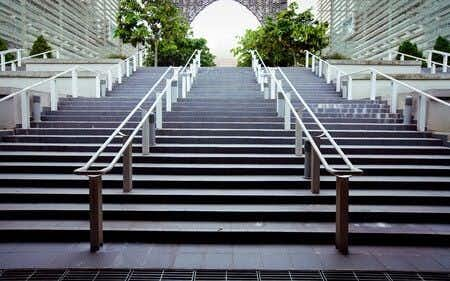This case involves a plaintiff who went to use the restroom before boarding a bus at a bus station. On the way to the restroom, which is accessible only via an exterior set of uneven and oddly configured shallow steps, the plaintiff held onto the handrail which was loose and unstable. The plaintiff lost his balance and fell, causing him to sustain a fracture of his left wrist and left ankle. The attorney retained an OSHA expert witness familiar with building code compliance to render an opinion of the property’s conditions and determine if it was up to standard on the day of injury. The building was first built around the late 1800’s, and had substantial alterations 1970. When the lease was assumed by defendant tenant coach bus company in 2003, landlord and tenant made alterations to interior of the space, but did not alter the outside steps or handrail. The handrail was first checked for looseness 2 years after the plaintiff suffered his injury, and repaired at that time. Tenant did get an occupancy permit when it took assignment of lease.
Question(s) For Expert Witness
1. Does the stairway comply with requirements of building code?
2. Do the ADA/Transportation Regulations require commercial bus operator to choose a bus customer service area that is already ADA compliant?
3. Do the state Building Maintenance code requirements for safe handrails, constitute a negligence per se violation, even if the tenant was not aware of loose railing?
4. Are these stairs out of Building Code compliance as it existed on the date of last major alterations?
Expert Witness Response E-006332
I believe I am qualified to consult on this case. I studied at Cornell and Columbia University. I am licensed to practice in this particular state and have recently worked on other cases in this state as well. I am extremely well versed with building codes and ADA compliance. As you note, there are various and complex fact issues. At least this case seems to pre-date the ADAAG 2010 requirements that went into effect in 2012 so the details will be found in ANSI 117 and the state building code. In chapter 3 of the building code that describes uses, assembly use is clearly defined and most likely applies to this area. Then, you have to apply chapter 10 and chapter 11, which will show that this station does not comply with code -- it is a non-conforming egress and entrance. The stair and railing are pretty clearly building code violations.
About the author
Michael Morgenstern
Michael is Senior Vice President of Marketing at The Expert Institute. Michael oversees every aspect of The Expert Institute’s marketing strategy including SEO, PPC, marketing automation, email marketing, content development, analytics, and branding.



